Beads on a String: Taking Stock
Nature study is, despite all discussions and perversions, a study of nature; it consists of simple, truthful observations that may, like beads on a string, finally be threaded upon the understanding and thus held together as a logical and harmonious whole. Therefore, the object of the nature study teacher should be to cultivate in the children powers of accurate observation and to build up within them understanding. (Anna Botsford Comstock, Handbook of Nature Study)
As soon as I felt a necessity to learn about the nonhuman world, I wished to learn about it in a hurry. And then I began to learn perhaps the most important lesson that nature had to teach me: that I could not learn about her in a hurry. The most important learning, that of experience, can be neither summoned nor sought out. The most worthy knowledge cannot be acquired by what is known as study — though that is necessary, and has its use. It comes in its own good time and its own way to the man who will go where it lives, and wait, and be ready, and watch. Hurry is beside the point, useless, an obstruction. The thing is to be attentively present. To sit and wait is as important as to move. Patience is as valuable as industry. What is to be known is always there. When it reveals itself to you, or when you come upon it, it is by chance. The only condition is your being there and being watchful. (Wendell Berry, “The Long-Legged House”)
**********
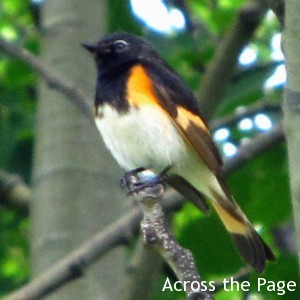 Both of these passages stir something deep in me. I’ve been frustrated lately with our nature study, feeling like we’re spinning our wheels. Yesterday I wrote a post about the virtues of becoming aware of nature even when you take a walk and don’t notice much that’s new to you, but awareness needs to be furnished with knowledge.
Both of these passages stir something deep in me. I’ve been frustrated lately with our nature study, feeling like we’re spinning our wheels. Yesterday I wrote a post about the virtues of becoming aware of nature even when you take a walk and don’t notice much that’s new to you, but awareness needs to be furnished with knowledge.
Both of these passages remind me that one of the ways “science” is different this year is that I don’t get to make the syllabus; nature does. Rather than being curriculum-driven, it’s observation-driven; we take walks and then read about what we notice. Both Berry and Comstock remind me that this knowledge comes “in its own good time and its own way.”
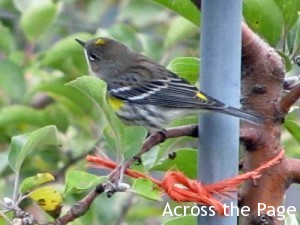 To comfort myself that it is indeed coming, I jotted down some of the things we’ve learned about since the summer. I’m sure when the girls wake up, they will think of additions. But here is what flowed from my pen on my own:
To comfort myself that it is indeed coming, I jotted down some of the things we’ve learned about since the summer. I’m sure when the girls wake up, they will think of additions. But here is what flowed from my pen on my own:
Birds we’ve seen for the first time:
- American redstart
- Juvenile red-tail
- Red-shouldered hawk
- Broad-winged hawk
- Wood duck
- Green heron
- Sora
- Eastern towhee
- Magnolia warbler
- Prothonotary warbler
- Yellow warbler
- Yellow-rumped warbler
- Common yellow-throat
- Red-eyed vireo (the untiring singer)
- Hermit thrush
- Wood thrush (still learning to distinguish the songs of these two!)
- Tree sparrow
- White-throated sparrow
- Kingfisher
- Yellow-billed cuckoo
- House wren
- Carolina wren
- Common raven
- Grouse
- Eastern kingbird
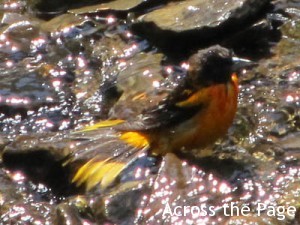 We’ve also dissected an owl pellet, seen a Baltimore oriole on its nest and one bathing in a stream, and observed some cool bird behavior from songbirds scolding a Cooper’s hawk to a hawk capturing its prey to crows building a nest and mobbing hawks. We’ve noticed countless woodpecker and sapsucker trees. And we’ve accumulated a lot of information about the nesting, eating, and migratory habits of these birds as well as the birds, not listed here, that we already knew.
We’ve also dissected an owl pellet, seen a Baltimore oriole on its nest and one bathing in a stream, and observed some cool bird behavior from songbirds scolding a Cooper’s hawk to a hawk capturing its prey to crows building a nest and mobbing hawks. We’ve noticed countless woodpecker and sapsucker trees. And we’ve accumulated a lot of information about the nesting, eating, and migratory habits of these birds as well as the birds, not listed here, that we already knew.
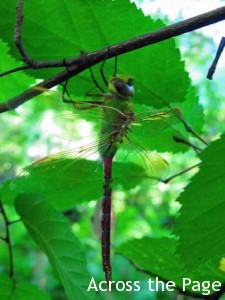 Other flying things we’ve seen for the first time:
Other flying things we’ve seen for the first time:
- Green darner (and other dragonflies)
- Bluet (and other damselflies)
- Butterflies: Wood nymph, comma, variegated fritillary, Eastern black swallowtail, clouded sulphur, pearl crescent, yellow swallowtail, spicebush swallowtail. We learned the name and behavior of the familiar cabbage white. And we got up-close and personal with any number of monarchs.
- Hawkmoth
- Bush katydid
- Milkweed beetle
- Gray treefrog
- Bedstraw hawkmoth caterpillar
- Crayfish — familiar, but we learned lots of new details through the Handbook
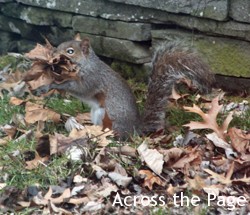 Mammals we’ve heard of but not directly observed before this year:
Mammals we’ve heard of but not directly observed before this year:
- Seen — beavers, muskrats, gray fox, coyote, mole shrew, mink (possibly — seen only fleetingly)
- Seen their signs and read about — fisher (tracks), raccoon (tracks), porcupine (tree-feasting), marten (possibly tracks), wood mouse (tracks and tunnels)
- We’ve observed gray squirrels building their nest in our back yard, first in the spring, and again over the last week.
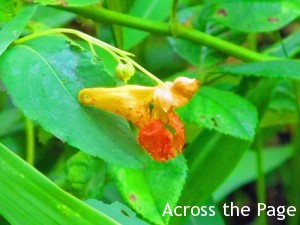
Plants and trees:
- Winterberry
- Larch
- Shagbark hickory
- Red vs. white oak
- Pitcher plants
- Touch-me-nots
- We learned a lot about milkweed, and how many species it hosts other than just monarchs
It’s encouraging in this quiet season to step back and remember discoveries over the last 8 months. I like Comstock’s metaphor of beads on a string; we’re simply gathering observations, trying to see relationships but having only an imperfect idea of the whole. It forces a certain humility. The wonder is how once you see something, you begin seeing it again and again. It can’t be forgotten — unlike the diagrams of prokaryotic and eukaryotic cells that the girls colored and labelled as part of last year’s science.
I often have the sense that we’ve stumbled onto something deeply important in this endeavor — undertaken kind of impulsively, but full of rewards that are difficult to measure. Our lives are becoming richer.
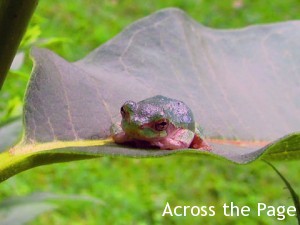
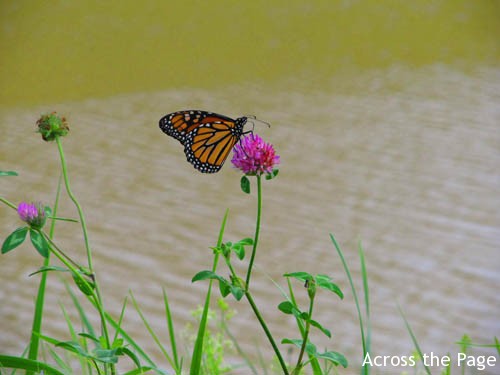
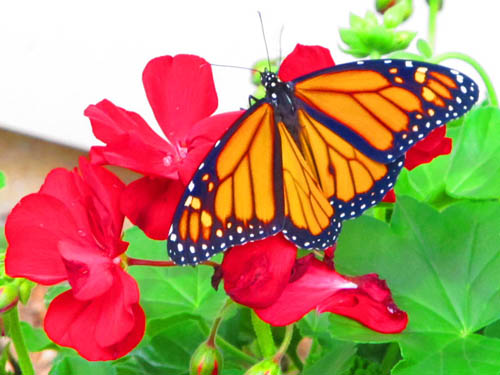
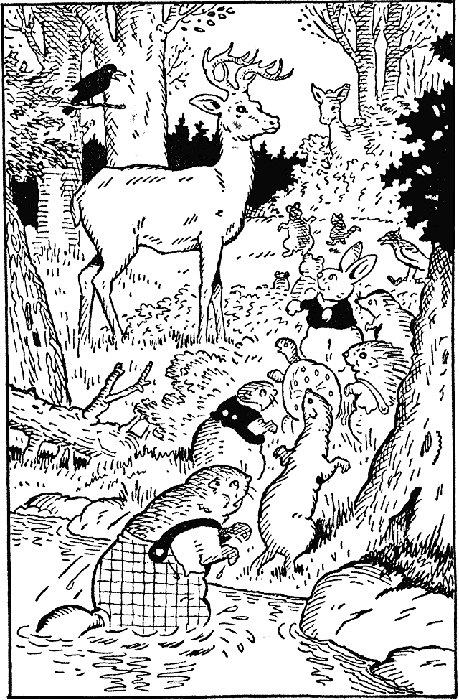
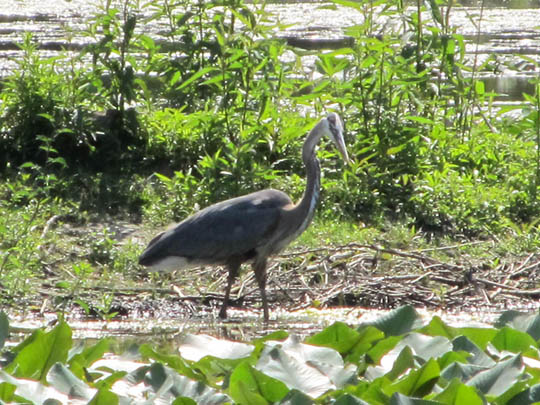
4 Comments
Alice@Supratentorial
I don’t know if you still need encouragement but your nature studies are a constant source of inspiration for me (and I’m sure many other readers).
Janet
Thanks, Alice — I always need encouragement! :-) I’m so glad if some of our pleasure in all of this is contagious.
Amy @ Hope Is the Word
Well, for what it’s worth, I am really, really inspired by all of your nature-related posts. In fact, I think I can trace my own interest in bird watching to your pictures and interest in it. I’m even figuring out exactly WHO is visiting our feeders now, which is thrilling!
I love this post. Thank you for sharing your experiences with us!
Janet
Thank you so much, Amy — that’s so encouraging! I hope you’ll share about your experience with the Backyard Bird Count next week. Maybe we can compare notes!